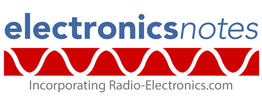Home » Component data » Diode (Schottky) data » this page
SS19 SMD Schottky Diode Data
Key data for the SS19 1A 90V SMD Schottky diode including key electrical parameters, performance, features, outline, package type and many other key datasheet details.
The SS19 is a 1 amp Schottky barrier diode with a maximum reverse voltage of 90V. IT is contained in a surface mount package to enable it to be included within many designs using PCBs where assembly will be in environments employing modern manufacturing techniques.
The diode is packaged in a DO214 style package for automated placement onto a printed circuit board. The device has two connections, one at either end that are bet around under the device to make contact with the solder on the PCB pads.
The diode features a guard ring in the silicon of the device structure to prevent unwanted early voltage breakdown. Without the guard ring, the internal electric fields in the region of the junction would be much greater and cause early breakdown reducing the reverse voltage level for the device.
The SS19 is one of a series of diodes, SS12 - SS100 offering various levels of maximum reverse voltage. The SS1x series of diodes are surface-mount equivalents of the 1N581x and 1N582x series, often used in modern designs where surface mount components are required.
This higher voltage diode is not available from as many manufacturers as the lower voltage devices, but it is still freely available and appears as a 'current' component in distributor listings.
Key details and performance parameters for the SS19 Schottky diode.
| SS19 Schottky diode datasheet parameters & data |
|
|---|---|
| Parameters | Details |
| Diode type | SMD 1A 90V Schottky diode rectifier |
| Package type | DO214 |
| Repetitive peak reverse voltage, VRRM | 90 |
| DC blocking voltage, VR | 90V |
| RMS reverse voltage, VR(RMS) | 63V |
| Forward continuous current, IF | 1A |
| Non-repetitive forward surge current, IFSM | 40 A for 8.3 µs |
| Power dissipation, PTOT | |
| Junction temperature (°C) | 150 |
| Forward voltage VF | 0.85V @1A |
| Reverse leakage IR | 0.2mA @25°C |
Outline & pinout:
Explanation of major diode parameters
| Parameter | Explanation |
|---|---|
| Repetitive peak reverse voltage, VRRM | This is the maximum value of the short period peak reverse voltage that can be sustained. |
| Working peak reverse voltage, VRWM | This is the maximum value of the continuous reverse voltage that can be applied to the diode. |
| DC blocking voltage, VR | This is the maximum reverse DC voltage that should be applied across the diode. |
| RMS reverse voltage, VR(RMS) | As many AC waveforms are quoted in RMS, this is the maximum reverse voltage that can be sustained where the voltage is expressed in terms of its RMS value. |
| Forward continuous current, IF | This is the maximum forward current that can be sustained by the diode. |
| Average rectified current, IF | This is the maximum average current value that can be handled by the diode. The parameter often states the load as this will affect the operation of the diode. |
| Non-repetitive forward surge current, IFSM | This is the maximum surge current that can be handled - it should only be present for a short time. |
| Parameter | Explanation |
|---|---|
| Power dissipation, PTOT | The maximum power dissipation that can be sustained within the device. |
| Junction temperature (°C) | This is the maximum temperature of the PN junction that can be sustained. Remember that the junction temperature can be much higher than the ambient temperature of the equipment. |
| Forward voltage VF | This parameter gives the forward voltage drop for a particular current passed through the diode. |
| Breakdown voltage VBR | This is the minimum voltage at which the diode may breakdown. If the current is not limited it will lead to the destruction of the device. |
| Leakage current IR | This is the current that flows under stated conditions when the diode is reverse biassed. |
| Diode capacitance CD | The diode capacitance, CD may also be referred to as the junction capacitance, CJ. All diodes have a certain capacitance across the PN junction. The value will be stated for a given reverse voltage. |
| Reverse recovery time | If a diode is initially driven in forward bias, and the polarity suddenly switches to reverse bias, the diode will still remain conducting for some time. The reverse recovery time is the time required for conduction to settle into the reverse bias state. |
These are the main operational amplifier parameters that have been included in our list. There are others, but these help quantify the main elements of the performance of the regulator, but are normally deemed to be less important.
Please note, that the data given is the best estimate we can give within a tabulated summary of this nature. Parameters also vary between manufacturers. Electronics Notes cannot accept any responsibility for errors, inaccuracies, etc, although we do endevaour to ensure the data is as accurate as possible.
Notes and supplementary information
• Availability & sources
The SS19 is available from a number of stockists and electronic component distributors many of which are given in the table below.
SS19 Component Distributor, Stock and Pricing
• Typical applications
The SS19 and other diodes in the series are aimed at circuits such as high frequency inverters, freewheeling, DC-DC converters, and polarity protection circuitry, etc.
Care must be taken not to exceed the 90V maximum reverse voltage, although for many designs, this should not be an issue.
 Written by Ian Poole .
Written by Ian Poole .
Experienced electronics engineer and author.
Return to Component Data menu . . .



